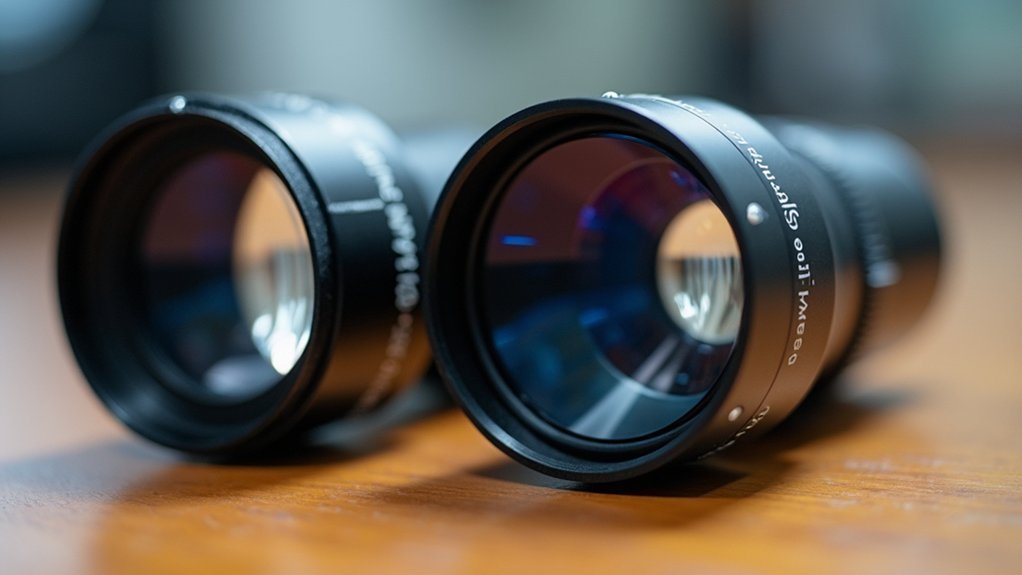Plan Fluorite objectives offer superior correction for chromatic aberration across 2-3 wavelengths, higher numerical apertures, and better contrast than Plan Achromat lenses. You’ll get sharper images with less color fringing, especially valuable for fluorescence microscopy and detailed brightfield work. Choose Plan Achromat for routine brightfield applications and budget constraints. Plan Fluorite justifies its higher price when you need enhanced resolution and clearer images. The differences become most apparent in specialized imaging techniques.
Understanding Basic Optical Principles of Microscope Objectives

When you’re examining specimens under a microscope, the objective lens serves as the critical component that determines image quality.
These objectives are designed to focus light and form clear images by correcting optical aberrations that naturally occur in lens systems.
The two most significant aberrations you’ll encounter are chromatic aberration (color fringing) and spherical aberration (focus variations across the field).
Plan Achromat objectives offer basic correction, addressing chromatic aberration in two wavelengths and spherical aberration primarily in green light.
Plan Fluorite objectives represent a step up in correction capability.
Plan Fluorite objectives elevate microscopy with their enhanced correction properties, delivering superior image clarity for demanding scientific applications.
They incorporate fluorite elements that reduce chromatic aberration across a wider spectrum—typically two to four colors—resulting in sharper images with better contrast.
You’ll notice this improvement especially when working with fluorescence applications or capturing fine structural details.
Key Differences Between Plan Fluorite and Plan Achromat Lenses
When choosing between microscope objectives, you’ll find that plan fluorite lenses offer superior chromatic aberration correction for two to three colors, while plan achromats correct for only two wavelengths.
Plan fluorites deliver higher numerical apertures and better contrast, making them ideal for fluorescence microscopy and applications requiring detailed imaging.
Despite their optical advantages, plan fluorites come at a higher price point than plan achromats, which remain cost-effective options for routine brightfield microscopy tasks.
Optical Correction Capabilities
The fundamental difference between plan fluorite and plan achromat objectives lies in their chromatic aberration correction capabilities. Plan fluorite objectives correct across 2-3 wavelengths, while plan achromats only correct for blue and red. You’ll notice this difference when capturing images that require accurate color reproduction.
| Feature | Plan Fluorite | Plan Achromat |
|---|---|---|
| Chromatic Correction | 2-3 wavelengths | 2 wavelengths (blue/red) |
| Spherical Aberration | Broad spectrum correction | Green light optimization |
| Numerical Aperture | Higher range | Lower range |
| Cost | More expensive | More affordable |
| Best Applications | Fluorescence & high-resolution | Routine brightfield |
When you need superior image fidelity, especially for fluorescence work, plan fluorite objectives deliver better correction across the color spectrum, though at a higher price point than their achromat counterparts.
Chromatic Aberration Management
Chromatic aberration management represents a critical distinction between these two objective types.
When you use Plan Achromat objectives, you’ll get correction for two wavelengths (red and blue), which is adequate for basic imaging but leaves noticeable color fringing, particularly in the green spectrum.
Plan Fluorite objectives offer superior correction across 2-4 wavelengths, markedly reducing unwanted color dispersion throughout your samples.
This enhanced correction directly translates to improved image quality, with sharper details and more accurate color reproduction. You’ll especially notice this difference during fluorescence microscopy, where precise wavelength management is essential.
While Plan Achromats provide a more budget-friendly option, the superior chromatic aberration control of Plan Fluorite objectives makes them the preferred choice for applications requiring high precision and minimal color distortion.
Price-Performance Relationship
Evaluating the cost-benefit balance between Plan Fluorite and Plan Achromat objectives reveals significant trade-offs you’ll need to contemplate. When examining the price-performance relationship, you’re fundamentally weighing budget constraints against imaging requirements.
| Feature | Plan Achromat | Plan Fluorite |
|---|---|---|
| Cost | More affordable | Higher investment |
| Chromatic Correction | Two wavelengths | Up to four wavelengths |
| Application Suitability | Basic brightfield | Advanced fluorescence |
Plan Achromat objectives deliver adequate results for routine microscopy at a lower price point. However, if you’re conducting detailed research requiring improved image quality, Plan Fluorite objectives justify their premium cost through superior resolution and reduced chromatic aberration. Your decision should ultimately align with your specific application needs and available funding—investing more initially may prevent costly upgrades later.
Performance Comparison in Brightfield Applications
When examining specimens under brightfield illumination, plan fluorite objectives consistently outperform their plan achromat counterparts in several key areas.
The higher numerical aperture of plan fluorite objectives allows for superior light-gathering capability, revealing fine details that might be missed with plan achromats.
You’ll notice markedly improved image quality with plan fluorites, particularly at the edges of your field of view where plan achromats often struggle.
The advanced correction for chromatic aberration means you’ll see sharper images with minimal color fringing, especially at higher magnifications. This becomes particularly valuable when observing unstained or faintly colored specimens.
While you’ll pay more for plan fluorite objectives, the enhanced resolution and reduced artifacts make them worth considering if brightfield microscopy is your primary application.
Chromatic Aberration Correction: How Each Type Handles Color

The fundamental difference between plan fluorite and plan achromat objectives lies in how effectively they manage chromatic aberration, an optical distortion that can greatly impact image quality.
Plan achromat objectives correct for two wavelengths (blue and red), improving color fidelity, but you’ll notice some color fringing in high-contrast images, especially at higher magnifications.
Plan achromats offer dual-wavelength correction but exhibit noticeable color fringing in high-contrast scenarios, particularly as magnification increases.
Plan fluorite objectives offer superior performance by correcting for 2-4 wavelengths. They utilize fluorite glass with a lower refractive index, considerably reducing color distortion compared to achromats.
When you’re working with applications requiring precise color differentiation, plan fluorites deliver higher resolution and better image quality by minimizing color fringing. This makes them ideal for critical work where color accuracy is essential, while achromats may struggle with these demanding applications.
Price vs. Performance: Budget Considerations for Your Lab
As you consider microscope objectives for your lab, the price differential between plan fluorite and plan achromat options presents a significant decision point. Plan Fluorite objectives deliver superior optical performance but at a higher cost, while Plan Achromat objectives offer budget-friendly alternatives with acceptable performance for basic applications.
| Factor | Plan Fluorite | Plan Achromat |
|---|---|---|
| Price | Higher investment | More affordable |
| Image Quality | Superior resolution | Good for basic imaging |
| Color Fidelity | Minimal aberration | Some color distortion |
| Best Use Case | Advanced research | Routine brightfield work |
Evaluate your specific research needs when making this investment decision. If your work demands high-resolution imaging with minimal optical distortion, the premium price of Plan Fluorite objectives becomes justified. For labs with tighter budgets, Plan Achromat objectives can serve as effective starting points.
Applications Where Plan Fluorite Excels

Plan Fluorite objectives shine in fluorescence microscopy where their superior chromatic aberration correction allows you to capture crisp, color-accurate images of fluorescent markers.
You’ll notice the difference when working with applications requiring high contrast and color differentiation, particularly in live cell imaging and dynamic studies.
If your research demands precise visualization of multiple fluorophores or involves low-light conditions where higher numerical apertures are beneficial, Plan Fluorite objectives will consistently outperform standard achromats.
Fluorescence Imaging Advantages
When working with fluorescence microscopy, you’ll find Plan Fluorite objectives offer considerable advantages over standard alternatives. Their low refractive index minimizes chromatic aberration, enabling clearer imaging across multiple wavelengths—crucial when visualizing different fluorophores simultaneously.
The higher numerical aperture of Plan Fluorite objectives captures more light from faintly labeled specimens, revealing details that might otherwise remain invisible in complex biological samples.
| Feature | Plan Fluorite | Plan Achromat |
|---|---|---|
| Wavelength Correction | 2-4 wavelengths | Limited correction |
| Chromatic Aberration | Notably reduced | More pronounced |
| Color Fidelity | High accuracy | Less accurate |
| Ideal Applications | Live-cell imaging, multi-color fluorescence | Routine brightfield |
You’ll notice dramatically improved resolution and contrast when using Plan Fluorite for fluorescence imaging, particularly when working with diverse fluorophores or when precise color representation matters in your research.
High-Contrast Scientific Applications
For high-contrast scientific applications, Plan Fluorite objectives deliver exceptional imaging performance that surpasses standard options. Their low refractive index dramatically reduces chromatic aberration, resulting in sharper images with superior clarity—crucial when you’re analyzing complex specimens.
When you’re conducting fluorescence microscopy experiments, you’ll appreciate how Plan Fluorite objectives resolve fine structural details while maintaining excellent color fidelity. These objectives typically correct for 2-4 wavelengths, making them ideal for multicolor fluorescence studies where accurate color reproduction matters.
In biomedical research requiring high-resolution visualization of cellular structures and dynamics, Plan Fluorite objectives offer distinct advantages over Plan Achromat alternatives.
You’ll notice markedly reduced distortion and enhanced image quality, particularly during live cell imaging where capturing subtle details can make a critical difference in your results.
When Plan Achromat Is the Better Choice
Although advanced objectives have their place in specialized research, you’ll find plan achromat objectives perfectly suitable for many common microscopy tasks.
These cost-effective options deliver satisfactory image quality for standard microscopy applications, particularly when working with transmitted light or routine observations.
When should you choose plan achromats?
- Budget constraints – They offer an affordable alternative without compromising essential functionality
- Educational settings – Perfect for teaching labs where chromatic correction for blue and red wavelengths is sufficient
- Brightfield imaging – Their NA of approximately 0.65 provides adequate resolution for general laboratory work
- Basic transmitted light microscopy – You’ll get clear, flat-field images without paying for corrections you don’t need
Plan achromats strike an ideal balance between performance and price for everyday microscopy needs.
Identifying Objective Types From Barrel Markings

Microscope objectives reveal their identity through specific markings engraved on their barrels. When examining your objective, you’ll find “Plan Fluor” designations on Plan Fluorite lenses, indicating enhanced chromatic aberration correction for superior image quality.
In contrast, Plan Achromat objectives display “Plan Achro” markings, signaling their two-wavelength correction and flat-field imaging capabilities.
Always check the numerical aperture (NA) value prominently displayed on the objective barrel. Higher NA values indicate better resolution and light-gathering ability—Plan Fluorite objectives typically feature higher NA values (around 0.75) compared to Plan Achromats (approximately 0.65).
The numerical aperture isn’t just a number—it’s your window into the microscopic world’s resolution potential.
These markings aren’t just labels; they’re practical guides to each objective’s performance characteristics, helping you select the right lens for your specific microscopy applications, whether you’re conducting fluorescence studies or routine observations.
Matching Objectives to Your Specific Imaging Requirements
Selecting the right microscope objective requires understanding your specific research needs and imaging requirements.
Plan Fluorite objectives excel in applications demanding superior color fidelity and high-quality images, particularly when chromatic aberration would compromise your results.
Plan Achromat objectives, while less sophisticated, offer adequate performance for routine microscopy at a lower cost.
- Fluorescence work: Choose Plan Fluorite for their enhanced ability to handle multiple wavelengths simultaneously
- Budget considerations: Plan Achromat provides cost-effective solutions for basic imaging needs
- Color accuracy: Plan Fluorite notably reduces chromatic aberration, essential for multicolor fluorescence
- Application type: Use Plan Achromat for routine brightfield microscopy, while Plan Fluorite shines in specialized applications requiring higher resolution
Your choice should ultimately align with your specific application requirements, balancing optical performance against budgetary constraints.
Frequently Asked Questions
What Is the Difference Between Plan and Plan Apo?
Plan objectives give you a flat field of view, while Plan Apo (apochromat) objectives correct for chromatic aberration across three wavelengths. You’ll get superior color correction and resolution with Plan Apo, but at higher cost.
What Is Plan Achromat?
Plan achromat objectives give you a flat field of view and correct for chromatic aberration in blue and red wavelengths. They’re more affordable than other plan objectives while still providing sharp images across your entire specimen.
What Is the Difference Between Plan Neofluar and Plan Apochromat?
Plan Neofluar offers moderate color correction (2-4 wavelengths) with fluorite glass, while Plan Apochromat provides superior correction (4-5 wavelengths) with multiple lens elements. You’ll get higher NA and better resolution with Apochromats, though at higher cost.
What Is the Difference Between Achromatic and Semi Plan?
Achromatic objectives correct for two wavelengths while semi plan objectives provide better field flatness. You’ll get about 65% focused FOV with achromats versus 80% with semi plans, though at a higher cost.
In Summary
You’ll find both plan fluorite and plan achromat objectives have their place in microscopy. Choose plan fluorites when you need higher resolution, better color correction, and superior fluorescence performance. Opt for plan achromats when you’re working with routine brightfield applications on a limited budget. Always match your objective type to your specific imaging needs rather than assuming the more expensive option is necessary.





Leave a Reply